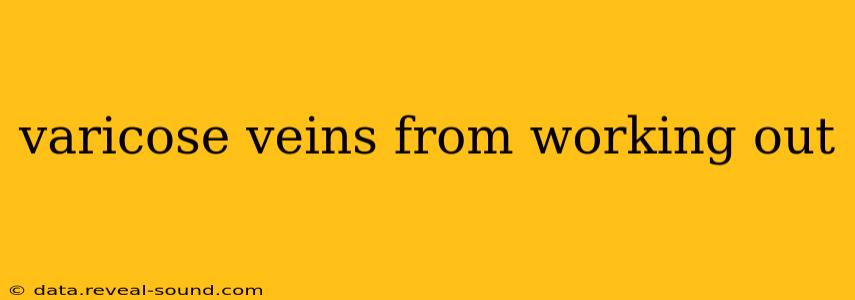Varicose veins, those unsightly, bulging veins often appearing on the legs, are a common concern. While genetics play a significant role, many wonder if strenuous exercise can contribute to their development or worsening. The relationship between working out and varicose veins is complex and not as straightforward as you might think. This article will explore the connection, addressing common questions and providing accurate information.
Can Working Out Cause Varicose Veins?
The short answer is: not directly. Working out itself doesn't cause varicose veins. However, certain types of exercise and pre-existing conditions can exacerbate the problem or increase the risk of developing them. The primary cause of varicose veins is weakened valves within the veins, preventing blood from flowing efficiently back to the heart. This leads to blood pooling, causing the veins to bulge and become visible. While exercise increases blood flow, it doesn't directly damage these valves.
What Types of Exercise Increase the Risk of Varicose Veins?
High-impact activities and those involving prolonged standing or straining can put extra pressure on the leg veins, potentially worsening existing varicose veins or increasing the risk in predisposed individuals. Examples include:
- Long-distance running: The repetitive impact and prolonged standing can strain leg veins.
- Weightlifting (heavy lifting): Straining during heavy lifts can increase pressure in the abdominal cavity, affecting venous return.
- Prolonged standing: Occupations requiring prolonged standing, even without intense physical activity, significantly increase the risk.
It's crucial to remember that these activities don't cause varicose veins but can worsen symptoms or accelerate their development in susceptible individuals.
Does Exercise Help or Hurt Varicose Veins?
The impact of exercise on varicose veins is nuanced. While certain types of exercise might exacerbate symptoms, regular, moderate exercise generally benefits overall circulatory health. Activities that improve circulation and strengthen leg muscles, like walking or swimming, can help improve venous return and reduce symptoms.
What Exercises Are Good for People with Varicose Veins?
Low-impact exercises are generally recommended for individuals with varicose veins. These include:
- Walking: A great way to improve circulation without putting excessive strain on the legs.
- Swimming: The buoyancy of water supports the body, reducing pressure on the legs.
- Cycling: Low-impact and effective for improving lower body circulation.
- Yoga: Gentle stretching can improve flexibility and blood flow.
It's always advisable to consult with a doctor or physical therapist before starting any new exercise program, especially if you have existing varicose veins. They can help you design a safe and effective plan.
Are There Other Factors That Contribute to Varicose Veins Besides Exercise?
Several factors contribute to the development of varicose veins, including:
- Genetics: A family history of varicose veins significantly increases your risk.
- Age: The risk increases with age due to the natural weakening of vein valves.
- Pregnancy: Hormonal changes and increased blood volume during pregnancy put extra pressure on the veins.
- Obesity: Excess weight puts additional stress on the veins.
- Prolonged sitting or standing: Lack of movement hinders blood circulation.
Addressing these factors, alongside adopting a healthy lifestyle that includes regular moderate exercise, can help mitigate the risk or manage existing varicose veins.
How Can I Prevent Varicose Veins?
While you can't completely prevent varicose veins if you're genetically predisposed, you can significantly reduce your risk by:
- Maintaining a healthy weight: Reducing excess weight alleviates pressure on the veins.
- Regular exercise (low impact): Improve circulation and strengthen leg muscles.
- Elevating your legs: Helps blood flow back to the heart.
- Wearing compression stockings: These can improve blood flow and reduce swelling.
- Avoiding prolonged periods of sitting or standing: Take regular breaks to move around.
This information is for general knowledge and does not constitute medical advice. Always consult with a healthcare professional for diagnosis and treatment of varicose veins or any health concerns. They can assess your individual risk factors and recommend the best course of action.
